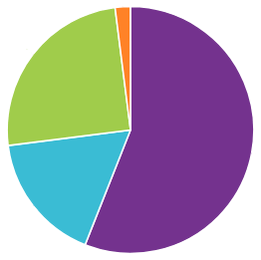Cinema of Europe
Cinema of Europe refers to the film industries and films produced in the continent of Europe.
Europeans were the pioneers of the motion picture industry, with several innovative engineers and artists making an impact especially at the end of the 19th century. Louis Le Prince became famous for his 1888 Roundhay Garden Scene, the first known celluloid film recorded. The Skladanowsky brothers from Berlin used their "Bioscop" to amaze the Wintergarten theatre audience with the first film show ever, from November 1 through 31, 1895. The Lumière Brothers established the Cinematograph; which initiated the silent film era, a period where European cinema was a major commercial success. It remained so until the art-hostile environment of World War II.[1]
Notable European early film movements include German Expressionism (1920s), Soviet Montage (1920s), French Impressionist Cinema (1920s), Poetic realism (1930s), and Italian neorealism (1940s); it was a period now seen in retrospect as "The Other Hollywood". The first large-scale film studio was also established in Europe, with the Babelsberg Studio near Berlin in 1912.
Post World War II movements include Free Cinema (1950s), French New Wave (1950s–60s), Polish Film School (1950s–60s), Czechoslovak New Wave (1960s), New German Cinema (1960s–80s), British New Wave (1950s–60s), Spaghetti Western (1960s) and Novo Cinema (1960s–70s). The turn of the 21st century has seen movements such as Dogme 95, New French Extremity and the Romanian New Wave.
History

19th century
Antoine Lumière realized, on 28 December 1895, the first projection, with the Cinematograph, in Paris.[2][3][4] In 1897, Georges Méliès established the first cinema studio on a rooftop property in Montreuil, near Paris.
20th century
According to one study, "In the 1900s the European film industry was in good shape. European film companies pioneered both technological innovations such as projection, colour processes, and talking pictures, and content innovations such as the weekly newsreel, the cartoon, the serial, and the feature film. They held a large share of the US market, which at times reached 60 per cent. The French film companies were quick in setting up foreign production and distribution subsidiaries in European countries and the USA, and dominated international film distribution before the mid-1910s... By the early 1920s, all this had changed. The European film industry only held a marginal share of the US market, and a small share of its home markets. Most large European companies sold their foreign subsidiaries and exited from film production at home, while the emerging Hollywood studios built their foreign distribution networks."[5]
The European Film Academy was founded in 1988 to celebrate European cinema through the European Film Awards annually.
Philippe Binant realised, on 2 February 2000, the first digital cinema projection in Europe, with the DLP CINEMA technology developed by Texas Instruments, in Paris.[6][7][8]
Founded in 1992 with funding from the MEDIA programme Creative Europe and from the Centre national du cinéma et de l'image animée CNC, France, Europa Cinemas is the first film theatre network focusing on European films. Its objective is to provide operational and financial support to cinemas that commit themselves to screen a significant number of European non-national films, to offer events and initiatives as well as promotional activities targeted at Young Audiences. Thanks to the support of Eurimages and the French Ministry of Foreign Affairs, the influence of Europa Cinemas extends to Eastern European countries, to the Balkans, to Russia and to Turkey.

Europa Cinemas in 2016: 41 countries, 644 cities, 1,078 cinemas, 2,648 screens MEDIA: 33 countries, 602 cities, 1,014 cinemas, 2,428 screens EURIMAGES: 3 countries, 37 cities, 58 cinemas, 205 screens MAE: 5 countries, 5 cities, 6 cinemas, 15 screens
Today US productions dominate the European market. On average European films are distributed in only 2 or 3 countries; US productions in nearly 10.[10][11] The top 10 most watched films in Europe between 1996 and 2016 were all US productions or co-productions. Excluding US productions the most watched movie in that period was The Intouchables, a French production, like most of the other movies in the top 10.[9] In 2016-2017 the only (partially) European film in the top ten of the most watched films in Europe was Dunkirk. Excluding it (which was a Netherlands, UK, France and US co-production[12]) the European film with the best results was Paddington 2, which sold 9.1 million tickets.[13]
Film festivals
- Others
Film awards
Directors
- French
- British
- Italian
- German
- Swedish
- Polish
- Dutch
- Austrian
- Danish
- Other
- Theo Angelopoulos (Greek)
- István Szabó (Hungarian)
- Hrafn Gunnlaugsson (Icelandic)
- Emir Kusturica (Serbian)
- Manoel Oliveira (Portuguese)
- Andrej Tarkovskij (Russian)
- Sergei Eisenstein (Russian)
- Luis Buñuel (Spanish)
- Pedro Almodóvar (Spanish)
- Milos Forman (Czech)
- Jiri Menzel (Czech)
- Otto Preminger (Austria-Hungary)
Actors
- Charlie Chaplin
- Greta Garbo
- Ingrid Bergman
- Jeanne Moreau
- Brigitte Bardot
- Jean Gabin
- Erland Josephson
- Max von Sydow
- Liv Ullmann
- Stellan Skarsgård
- Pernilla August
- Lena Olin
- Peter Stormare
- Anna Q. Nilsson
- Ghita Nørby
- Bibi Andersson
- Harriet Andersson
- Gérard Depardieu
- Laurence Olivier
- Ingrid Thulin
- Peter O'Toole
- Minnie Driver
- Juliette Binoche
- Michael Redgrave
- Vanessa Redgrave
- Nastassja Kinski
- Claudia Cardinale
- Sophia Loren
- Marcello Mastroianni
- Giulietta Masina
- Catherine Deneuve
- Catherine Zeta-Jones
- Anthony Hopkins
- Daniel Day-Lewis
- Vivien Leigh
- Audrey Hepburn
- Charlotte Gainsbourg
- Gina Lollobrigida
- Bruno Ganz
- Fanny Ardant
- Charlotte Rampling
- Isabelle Huppert
- Louis Jouvet
- Isabelle Adjani
- Daniel Auteuil
- Rutger Hauer
- Emmanuelle Béart
- Vittorio Gassman
- Michael Caine
- Julie Christie
- Michel Piccoli
- Erich von Stroheim
- Alec Guinness
- Melina Mercouri
- Irene Papas
- Maurice Chevalier
- Silvana Mangano
- Kristin Scott Thomas
- Kate Winslet
- Derek Jacobi
- Dirk Bogarde
See also
References
- ↑ "Cinema Europe: The Other Hollywood". Rovi. The New York Times. Retrieved 2013-07-18.
- ↑ December 28, 1895.
- ↑ Georges Sadoul, Histoire du cinéma mondial, des origines à nos jours, Flammarion, Paris, 1968, p. 19
- ↑ Institut Lumière. Archived 2014-01-05 at the Wayback Machine.
- ↑ Bakker, Gerben (2005-05-01). "The decline and fall of the European film industry: sunk costs, market size, and market structure, 1890–19271". The Economic History Review. 58 (2): 310–351. doi:10.1111/j.1468-0289.2005.00306.x. ISSN 1468-0289.
- ↑ Cahiers du cinéma, n°hors-série, Paris, April 2000, p. 32 (cf. also Histoire des communications, 2011, p. 10.).
- ↑ Cf. Binant, " Au cœur de la projection numérique ", Actions, 29, Kodak, Paris, 2007, p. 12. Archived May 22, 2014, at the Wayback Machine.
- ↑ Claude Forest, « De la pellicule aux pixels : l'anomie des exploitants de salles de cinéma », in Laurent Creton, Kira Kitsopanidou (sous la direction de), Les salles de cinéma : enjeux, défis et perspectives, Armand Colin / Recherche, Paris, 2013, p. 116.
- 1 2 Comai, Giorgio (9 April 2018). "Europeans at the cinema". OBC Transeuropa/EDJNet. Retrieved 23 August 2018.
- ↑ Christian Grece (May 2018). How do films circulate on VOD services and in cinemas in the European Union? (Report). European Audiovisual Observatory. p. 20. Retrieved 23 August 2018.
- ↑ Bona, Marzia (14 February 2018). "Europeans at the cinema, from East to West". OBC Transeuropa/EDJNet. Retrieved 23 August 2018.
- ↑ "Dunkirk". British Film Council. Retrieved 23 August 2018.
- ↑ Cebrián, Sergio (5 July 2018). "European cinema regains ground". VoxEurop/EDJNet. Retrieved 23 August 2018.
- ↑ Bordwell, David (2005). Figures Traced in Light: On Cinematic Staging. University of California Press. p. 144. ISBN 9780520241978.
Because reputations were made principally on the festival circuit, the filmmaker had to find international financing and distribution and settle for minor festivals before arriving at one of the Big Three (Berlin, Cannes, Venice).
- ↑ Wong, Cindy Hing-Yuk (2011). Film Festivals: Culture, People, and Power on the Global Screen. Rutgers University Press. p. 5. ISBN 9780813551104.
Whether we talk about the Big Three festivals—Cannes, Venice, Berlin—look at Sundance, Tribeca, and Toronto in North America, or examine other significant world festivals in Hong Kong, Pusan, Locarno, Rotterdam, San Sebastián, and Mar del Plata, the insistent global icons of all festivals are films, discoveries, auteurs, stars, parties, and awards.
External links
- Europa Cinemas
- Top 10 movies from Spain according to IMDB.com
- Cineuropa
- European Cinema Research Forum
- European Film Promotion
- French Trade-Union article about cinema in Europe, may 2009
- 7 Surprising European Films A look at European game changers from 2000 to 2011
- European Audiovisual Observatory
- European Film Industry Statistics
- LUMIERE European Cinema Database
